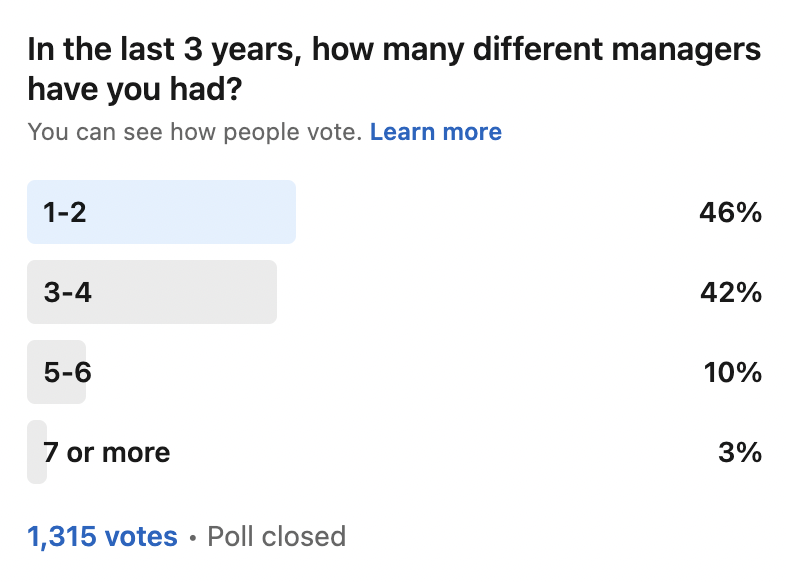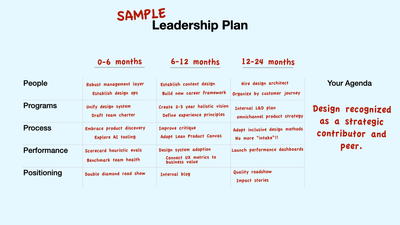The 'management carousel' inhibits UX professional growth
(this post is a bit of a muddle, but addresses what I see as a crisis in our field, and so I wanted to get these ideas out there, warts and all.)
A manager has many responsibilities, but the job boils down to "getting the most out of their team." This means working with the team to get desired outcomes (high quality, customer and business impact, positive internal relationships), and to help team members grow in their careers.
Recently, I've been part of conversations that illuminate a crisis in management which in turn is failing UX professionals. When Abby Covert joined Jesse and I on our podcast, she compared the companies we work with to the Ship of Theseus, where all the individual pieces change, though the ship stays the same, and how we need a "fairy godmother who is going to shepherd us through the organization," because "management in this industry changes over very quickly." This was reinforced in a totally separate discussion I had with a Sr Designer, who'd been in the same company for 3 or 4 years, and had 6 or 7 managers over that span.
For my own curiosity I launched a poll on LinkedIn asking people how many different managers they'd had in the last 3 years. The results:

With a little arithmetic, you see that more than half of the respondents have a new manager at least every year, with a decent portion having 2 new managers every year.
The Management Carousel is detrimental to team member growth
A team member works with a manager on a growth plan, that manager starts them on this path, but then the team member shifts to a new manager, and that new manager is likely trying to get up-to-speed on a whole bunch of matters, so career growth stalls, and if managers keep turning over, the team member cannot advance.
Such stalling isn't just a problem for the team member, though. It damages the broader organization in two ways. The most obvious is, if team members aren't growing, they're not getting better at their job, so the work doesn't improve.
But more crucially, when team members don't see a growth path, they leave. A few years ago, Todd Zaki Warfel conducted research and analysis on careers in design, and found that the second most common reason for people to leave a company was "lack of career path."
The "lack of career path" is particularly acute in UX/Design
The Management Carousel is neither new, nor specific to UX and Design. That said, I think it's more of a problem in these fields, because there are not broad industry standards for what it means to grow as a professional. Particularly for the early-career professional looking ahead, their potential growth paths appear to be covered in ivy and vines, and the best that most companies do is give them a machete and say, "Good luck."
How to help people grow
The Fairy Godm---, err, Career Counselor
Abby's comment about a "fairy godmother" may sound glib, but I think it points to a real solution. UX/Design orgs should have someone in the role of Career Counselor. This is not a manager, but someone who works across the whole organization to advocate for employees' development, and work with team members to chart their paths. In smaller orgs, this would be a role that someone plays (probably someone in Design Operations who has more of a 'people' bent than a 'programs' bent), and then as a team scaled, it could become a dedicated position.
Empower Employees with Robust Career Architectures
When we accept the Management Carousel as a given, it becomes clear that career development must be placed in the hands of the only constant: the employees. They require content and tools to figure out how they can grow. This doesn't mean that managers aren't involved, it just means that the process begins and ends with the team member.
As such, companies need to build robust and understandable career architectures that illuminate paths forward. Many teams have built career ladders or some other leveling framework, but that is only just the beginning. In work I've been doing over this past year, I've crafted more robust architectures built upon three components:
Capabilities
At the heart of professional development are the Capabilities needed to do the work: - Craft skills - Strategic mindset and tools - Professional capabilities
Leveling
An org-wide Leveling Framework structures a set of expectations for experience, autonomy, and scope at each career level, and across Manager and IC tracks.
Disciplines
Within any function is a set of Disciplines that part of the organization is responsible for. For UX, that’s typically UX Design, UX Research, and Content Design.
Specific Roles are found at the intersection of Levels and Disciplines, with suitability and readiness made clear by competency in skills.
(At some point, I'll be publishing more of my work on such architectures. Until then, if you're interested in learning more, I'm leading a workshop on the subject from 12-15 September 2022 for the Design Ops Summit.)
There's a lot more to unpack from here
I've only scratched the surface of what I think is a crisis in management for the Design / UX field. True lasting solutions will need broad community and industry support, including real professionalization (certification, licensing, etc.) brought forth by credible professional organizations (like the Interaction Design Association or the User Experience Professionals Association) that establish an outline of what it means to advance in your career.


Member discussion